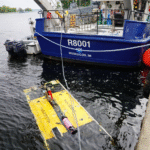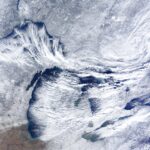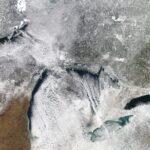What is lake effect snow? In the Great Lakes region, hazardous winter weather often happens when cold air descends from the Arctic region. Lake effect snow is different from a low pressure snow storm in that it is a much … Continue reading
Tag Archives: winter

February 22, 2024
by Gabrielle Farina
Comments Off on Q&A with NOAA scientists: Causes and impacts of 2024’s historically low Great Lakes ice cover
Q&A with NOAA scientists: Causes and impacts of 2024’s historically low Great Lakes ice cover
Many people have questions about the historically low Great Lakes ice cover this winter, and we’ve got answers! NOAA GLERL’s Bryan Mroczka (Physical Scientist) and Andrea Vander Woude (Integrated Physical and Ecological Modeling and Forecasting Branch Chief) answer the following … Continue reading
Lake effect snow: What, why and how?
As fall comes to a close, those who live and work in the Great Lakes region are wondering what weather this winter has in store. An El Niño Advisory is currently in effect, which means El Niño conditions have developed … Continue reading
February 17, 2023
by Gabrielle Farina
Comments Off on Low ice on the Great Lakes this winter
Low ice on the Great Lakes this winter
Ice coverage has reached a record low in the Great Lakes for this time of year. As of February 13, 2023, only 7 percent of these five freshwater lakes was covered in ice. Read the full story on NOAA Research.

August 10, 2022
by Gabrielle Farina
Comments Off on New under-ice observing capabilities could lead to new discoveries in the Great Lakes
New under-ice observing capabilities could lead to new discoveries in the Great Lakes
In the world of Great Lakes research, the start of winter traditionally signals the end of fieldwork for the year…This break leads to a several-month gap in most of GLERL’s field data, but this project aims to fill that gap using the high-tech SAAB Sabertooth AUV. Continue reading
April 23, 2021
by Gabrielle Farina
9 Comments
Looking back: The ups and downs of Great Lakes ice cover in 2021
It’s no secret that the Great Lakes had a wild ride in terms of ice cover this past winter. From a slow start that led to near-record low ice cover in January, to the sudden widespread freeze just a few … Continue reading
November 20, 2020
by Margaret Lansing
Comments Off on Lake effect snow: What, why and how?
Lake effect snow: What, why and how?
Winter is nearly here — and those who live and work in the Great Lakes region are already wondering what the winter of 2021 has in store. Early indications suggest a La Niña winter pattern, which shifts the odds towards cooler, … Continue reading
The HAB season is over, but the work goes on
It’s nearly winter here in the Great Lakes—our buoys are in the warehouse, our boats are making their way onto dry land, and folks in the lab are working hard to assess observed data, experiments, and other results from this … Continue reading
Great Lakes in winter: Water levels and ice cover
The Great Lakes, along with their connecting waterways and watersheds, make up the largest lake system on the planet—more than 20% of the world’s surface freshwater! Water levels on the lakes change in response to a number of factors, and these … Continue reading

November 15, 2017
by Katherine Glassner-Shwayder
Comments Off on New algorithm to map Great Lakes ice cover
New algorithm to map Great Lakes ice cover
NOAA’s Great Lakes Environmental Research Laboratory (GLERL) is on the cutting edge of using satellite remote sensing to monitor different types of ice as well as the ice cover extent. To make this possible, an algorithm—a mathematical calculation developed at GLERL … Continue reading


